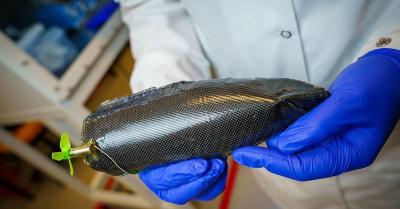Researchers from the University of California San Diego and the University of Southern Mississippi recently designed a graphene-enhanced structural supercapacitor. Structural supercapacitors hold promise to expand the energy capacity of a system by integrating load-bearing and energy-storage functions in a multifunctional structure, resulting in weight savings and safety improvements.
As a proof of concept, the researchers used their structural supercapacitor to build a miniature solar-powered boat. The supercapacitor was molded to form the boat’s hull and then fitted with a small motor and circuit. The circuit was connected to a solar cell. When exposed to sunlight, the solar cell charges the supercapacitor, which in turn powers the boat’s motor. In tests, the boat was able to cruise across the water, demonstrating the efficacy of this innovative energy storage solution.
The device consists of the standard supercapacitor components: a pair of electrode surfaces separated by an electrolyte, which facilitates the flow of ions between the electrodes. What sets this device apart is the combination of materials selected to boost both mechanical strength and electrochemical performance.
The electrodes are made from carbon fibers woven into a fabric. This carbon fiber fabric itself provides substantial structural strength. Moreover, it is coated with a special mixture composed of a conductive polymer and reduced graphene oxide, which significantly enhances ion flow and energy storage capacity.
The solid electrolyte, another critical component, is a blend of epoxy resin and a conductive polymer called polyethylene oxide. The epoxy resin offers structural support, while the incorporation of polyethylene oxide fosters ion mobility by creating a network of pores throughout the electrolyte.
While this represents a significant advancement toward structural energy storage, the researchers note that there is still much work to be done. Supercapacitors in general have high power density, meaning they can deliver big bursts of energy quickly, but they typically have lower energy density compared to batteries.
“Our future work will focus on increasing the energy density of our supercapacitor and making it comparable to some battery packs,” said study first author Lulu Yao, a materials science and engineering Ph.D. student in Ng’s lab. “The ultimate goal would be to achieve both higher energy density and power density.”




